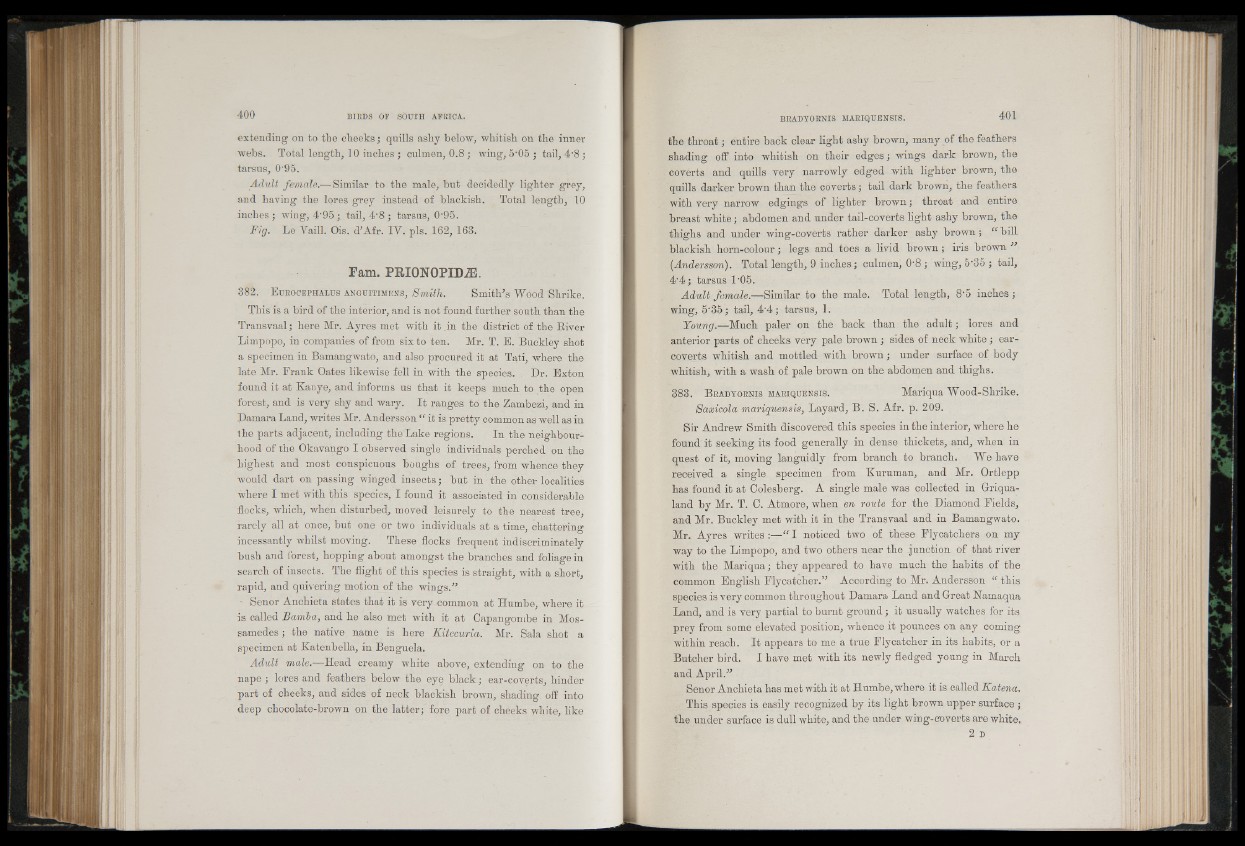
extending on to the cheeks; quills ashy below, whitish on the inner
webs. Total length, 10 inches ; culmen, 0.8 ; wing, 5'05 ; tail, 4-8 ;
tarsus, 0’95.
Aclult female.— Similar to the male, but decidedly lighter grey,
and having the lores grey instead of blackish. Total length, 10
inches ; wing, 4'95; tail, 4‘8 ; tarsus, 0‘95.
Fig. Le Vaill. Ois. d’Afr. IY. pis. 162, 168.
Fam. PRIONOPIDiE.
382. E u r o c e p h a l u s a n g u i t i m h n s , Smith. Smith’s Wood Shrike.
This is a bird of the interior, and is not found further south than the
Transvaal; here Mr. Ayres met with it .in the district of the River
Limpopo, in companies of from six to ten. Mr. T. E. Buckley shot
a specimen in Bamangwato, and also procured it at Tati, where the
late Mr. Frank Oates likewise fell in-with the species. . Dr. Exton
found it at Kanye, and informs us that it keeps much to the open
forest, and is very shy and wary. It ranges to the Zambezi, and in
Damara Land, writes Mr, Andersson “ it is pretty common as well as in
the parts adjacent, including the Lake regions. In the neighbourhood
of the Okavango I observed single individuals perched on the
highest and most conspicuous boughs of trees, from whence they
would dart on passing winged insects; but in the other localities
wher.e I met with this species, I found it associated in considerable
flocks, which, when disturbed, moved leisurely to the nearest tree,
rarely all at once, but one or two individuals at a time, chattering
incessantly whilst moving. These flocks frequent indiscriminately
bush and forest, hopping about amongst the branches and foliage in
search of insects. The flight of this species is straight, with a short,
rapid, and quivering motion of the wings.”
- Senor Anchieta states that it is very common at Humbe, where it
is called Bamba, and he also met with it at Capangombe in Mos-
samedes; the native name is here Kitecuria. Mr. Sala shot a
specimen at Katenbella, in Benguela.
Adult male.—Head creamy white above, extending on to the
nape; lores and feathers below the eye black; ear-coverts, hinder
part of cheeks, and sides of neck blackish brown, shading off into
deep chocolate-brown on the latter; fore part of cheeks white, like
the throat; entire back clear light ashy brown, many of the feathers
shading off into whitish on their edges; wings dark brown, the
coverts and quills very narrowly edged with lighter brown, the
quills darker brown than the coverts; tail dark brown, the feathers
with very narrow edgings of lighter brown; throat and entire
breast white; abdomen and under tail-coverts light ashy brown, the
thighs and under wing-coverts rather darker ashy brown; “ bill
blackish horn-colour; legs and toes a livid brown ; iris brown ”
[Andersson). Total length, 9 inches; culmen, 0'8 ; wing, 5'35 ; tail,
4'4; tarsus l -05.
Adult female.—Similar to the male. Total length, 8'5 inches;
wing, 5'35; tail, 4'4 ; tarsus, 1.
Young.—Much paler on the back than the adult; lores and
anterior parts of cheeks very pale brown ; sides of neck white; ear-
coverts whitish and mottled with brown; under surface of body
whitish, with a wash of pale brown on the abdomen and thighs.
383. B e a d y o r n i s m a r i q u e n s i s . Mariqua Wood-Shrike.
Saxícola mariquensis, Layard, B, S. Afr. p. 209.
Sir Andrew Smith discovered this species in the interior, where he
found it seeking its food generally in dense thickets, and, when in
quest of it, moving languidly from branch to branch. We have
received a single specimen from Kuruman, and Mr. Ortlepp
has found it at Colesberg. A single male was collected in Griqua-
land by Mr. T. C. Atmore, when en route for the Diamond Fields,
and Mr. Buckley met with it in the Transvaal and in Bamangwato.
Mr. Ayres writes :—“ I noticed two of these Flycatchers on my
way to the Limpopo, and two others near the junction of that river
with the Mariqua; they appeared to have much the habits of the
common English Flycatcher.” According to Mr. Andersson “ this
species is very common throughout Damara Land and Great Namaqua
Land, and is very partial to burnt ground; it usually watches for its
prey from some elevated position, whence it pounces on any coming
within reach. It appears to me a true Flycatcher in its habits, or a
Butcher bird. I have met with its newly fledged young in March
and April.”
Senor Anchieta has met with it at Humbe, where it is called Katena.
This species is easily recognized by its light brown upper surface;
the under surface is dull white, and the under wing-coverts are white.
2 D